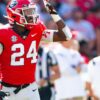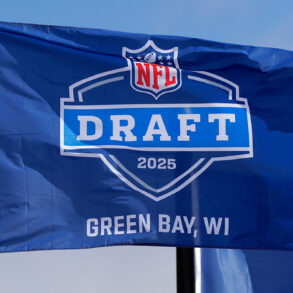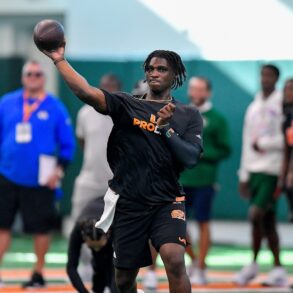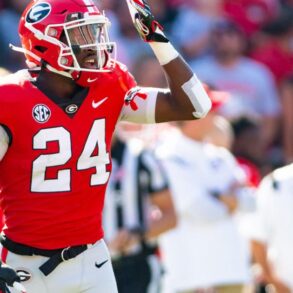There is something funky about the draft being one of the NFL’s marquee events. At root, it’s a man stepping to the podium, being booed and reading names. The NFL still dominates Sundays … and Mondays … and Thursdays … and playoff Saturdays during the season; the draft allows the league to gobble up the offseason months too. But as interest continues to grow, there has been relatively little pushback from those who make the draft work: the prospects, particularly those slated to go at the top of the first round.
Think about it. Your reward for being one of the best college athletes in the country is to wind up on one of the worst rosters in the NFL, typically one beset by mismanagement at the top, iffy coaching or a third-rate roster. Quarterbacks can win with teams that draft them No 1 overall – Peyton Manning and Troy Aikman are a couple of examples – but more often than not, the top quarterbacks end up in a spot where they’re likely to fail. There is a reason that Sam Darnold and Baker Mayfield found success after they were let go by the teams that selected them in the top three. Environment is king – having no say over where they start their career puts the best prospects at the whims of blundering franchises. Is there a system that can maintain the interest and parity the league craves, while handing some agency to players over their careers – or at least not reward floundering franchises?
No system is perfect: all the ideas below have flaws. But they’re at least worth thinking about.
Flip-flop the draft order
Rather than have teams slotted 1-32 based on their record the year before, those at the bottom of the league standings would not be rewarded with the earliest picks. Instead, the teams closest to the playoffs would “earn” the top draft choices.
The 14 teams that make the playoffs would still hold picks No 18 through No 32, but the non-playoff teams would be rewarded for how close they came to making the postseason. In that scenario this year, Seattle would hold the No 1 overall pick as the team with the best record to miss the playoffs in 2024. The Titans, who had the worst record in 2024, would pick at 18.
Flipping the order would ding the league’s sense of parity, making it tougher for failing franchises to quickly reboot. But it would make the end of the league’s regular season spicier, as teams fight to get closer to the playoff race. Rather than hand a top prize to the league’s weakest franchises, it would encourage rebuilding teams trying to chase the postseason.
There would be obvious downstream effects. Would a team tank out of a playoff spot to try to snag the No 1 overall pick? Would terrible teams be mired in futility forever without a top-five selection? But no system is perfect – and this one would encourage teams to be more aggressive chasing in-season moves, and put more top prospects on teams with solid foundations.
A draft lottery
A more palatable solution: a lottery system for all non-playoff teams. The NBA, NHL and MLB all employ weighted draft lottery systems, with the franchises with the weakest records given the best odds of landing a top pick. The NBA instituted its lottery in 1985 to fend off teams from tanking for top picks, and then flattened its weighting in 2019 to curb the latest efforts of franchises to lose their way into a franchise-altering player. Unlike the NBA or NHL, the NFL has not been a victim of serious tanking efforts (although some have tried). The season is too small. Careers are on the line. The lack of guaranteed contracts makes every rep an audition for fringe and rotational players looking for a new deal. One player, even a gifted quarterback prospect, cannot change an NFL franchise the way someone like Victor Wembanyama can in the NBA. Not since Andrew Luck have multiple franchises tried to chuck a season away for a top quarterback prospect. But there remains some late-season chicanery as teams jockey for position. And with the prospect of Arch Manning on the horizon, franchises who are out of the playoff picture by Thanksgiving will probably start maneuvering to select the Texas quarterback No 1 overall next season.
A lottery would give the league another showcase event in the draft cycle, and tilt the odds that some well-run franchises would leap up the draft board. Imagine the pandemonium if the 49ers or Seahawks snagged the top spot this season, with Travis Hunter waiting in the wings.
Good for league parity? Possibly. Handing the players some say in their destination? No. A chance that Mel Kiper melts into a puddle on set? Absolutely. For the drama alone, it’s worth the league investigating.
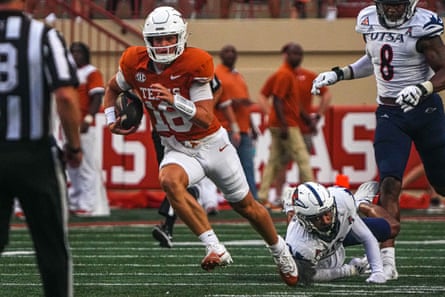
Waiving the eligibility rule
NFL rules state that a player must be three years removed from high school to be eligible for the draft. According to the league, the game is too physically and mentally demanding for an 18-year-old to cope with. But the unspoken part of the NFL’s criteria is that it gives teams more time to evaluate players, using college football as an effective minor league. In the pre-NIL era, when student-athletes were working for free, it was a grim spectacle. With players now able to earn money in college, the system is less grotesque.
But the eligibility rules can still be reworked, potentially formalizing college football as the pipeline system to the pros. There are multiple ways of tinkering. One: to have all players eligible to be drafted, but not eligible to play until they’re three years removed from college. In that world, franchises would decide whether it’s worth drafting, stashing and developing a player until they can see the field, or select a prospect they know can play as a rookie.
In a recent Pro Football Focus all-eligible mock draft, five players not eligible for this year’s class were selected in the top 10. Some of those players will inevitably fade away by the time they are eligible to be picked in real life. Injuries could sap some potential, or weaknesses could be exposed. But why should those players not be able to cash in on their draft stock today?
after newsletter promotion
As college football becomes increasingly professionalized, players should be able to choose when to test the NFL waters. Franchises should decide whether to select a talented player a year or two before they are eligible to play on Sundays.
The league could either allow teams to select players and make them a part of their practice squad until they can play, or have teams retain the draft rights of a player while they’re still in college. If the players are being paid in college, there is no downside to them being on the NFL’s books. It would be up to the player to decide when they want to leave school and enter the pros, rather than arbitrarily operating on the league’s timeline. And it would be up to teams to decide if they would rather take Arch Manning No 1 overall this season and sit him for a year or wade into this year’s eligible crop of quarterbacks.
Shifting the requirements would hand some say to players over their careers and give them a chance to earn off their talent before a potential injury robs them of their opportunity to earn a pro contract. It would also end the non-stop moaning from the league’s executives that college football is not adequately developing players.
Salary pool
If you were starting from scratch, a salary pool makes more sense than a traditional draft. Remove yourself from the big boards and mock drafts, and you’re left wondering why players have no say over where they work. After all, Starbucks does not accept top applicants and then send them to its worst outlet.
A salary pool would be an augmented version of the traditional draft. The team with the worst record would receive the largest pool of cash, descending to the Super Bowl champions, who would get the least. Let’s say this year, the Titans get $60m in rookie money and the Eagles get $30m. From there, teams and prospects are free to negotiate as they see fit. A team could splurge all its money on a generational prospect, or spread the wealth across 15 intriguing rookies.
The idea of an “auction” draft is unsavory, at best. The sinister undertones do not need describing in more detail. But by implementing a negotiated system rather than a highest-bidder scheme, players would be given as much power as owners by having the opportunity to balance the best contract they can sign with the right environment. Maybe Travis Hunter would leave some money on the table to line up with Patrick Mahomes or Josh Allen, or maybe he would like to make gobs of money from the Giants or Browns. It would be his choice.
By tiering the pool available to each franchise, the teams at the bottom of the standings would still have an upper hand in negotiations, allowing them to chuck more money at the top prospects or share the money across several second-tier prospects to rebuild. Baseball has moved to a similar salary pool for young, overseas rookies.
The idea will probably never pass muster with the league. It would remove the tension of draft night, robbing viewers of televisual drama, and the league of attention. But it could lead to a frenetic, weeks-long process, akin to free agency, with teams waiting on the top dominoes to fall. Plus, every fanbase would know they have a chance at the premium prospects. By making it a negotiation rather than a selection process, players would have some control over where they play, and basing the salary pool on a team’s record from the year before would help maintain a sense of parity.
This post was originally published on this site be sure to check out more of their content.




